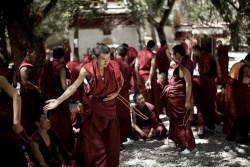Difference between revisions of "The Development of Madhyamaka"
(Created page with " Madhyamaka or Mādhyamika is first Mahāyāna Buddhist school in India. The name Mādhyamika (one who follows the middle way) is derived fro...") |
|||
| Line 1: | Line 1: | ||
| − | + | <nomobile>{{DisplayImages|4246|2167}}</nomobile> | |
| − | [[Madhyamaka]] or [[Mādhyamika]] is first [[Mahāyāna]] [[Buddhist]] school in [[India]]. The [[name]] [[Mādhyamika]] (one who follows the [[middle way]]) is derived from the [[word]] [[Madhyamaka]], found in the title [[Madhyamakakārikā]] (MMK), perhaps the most important work of Nāgārjun, the founder of the school. | + | [[Madhyamaka]] or [[Mādhyamika]] is first [[Mahāyāna]] [[Buddhist]] school in [[India]]. The [[name]] [[Mādhyamika]] (one who follows the [[middle way]]) is derived from the [[word]] [[Madhyamaka]], found in the title [[Madhyamakakārikā]] (MMK), perhaps the most important work of Nāgārjun, the founder of the school. |
| − | The | + | The school is referred to as [[dBu-ma-pa]] (the school of the middle) in [[Tibet]], [[San-lun-tsung]] (the [[three treatises school]]) in [[China]], and [[Sanronshū]] in [[Japan]]. According to [[Yūichi Kajiyama]], [[Indian Mādhyamika]] may historically be divided into three stages, early, middle, and late. ([[Kajiyama]], “[[Mādhyamika]],” The {{Wiki|Encyclopedia}} of [[Religion]], ed. {{Wiki|Mircea Eliade}}, Vol. 9, {{Wiki|New York}}: Macmillan Publishing Company, 1987: 71-77) |
| − | |||
| − | The | + | The Early Period. |
| − | |||
| − | + | This period is marked by two great figures, [[Nāgārjuna]] and [[Āryadeva]], and a lesser one, [[Rāhulabhadra]]. | |
| − | The [[tradition]] flourished during the early [[T’ang period]] but began to {{Wiki|decline}} after Hsuan-tsang’s [[transmission]] of the works of the [[Yogacara school]] to [[China]]. [[Ekan]], a [[Korean monk]], introduced the [[San-lun]] [[doctrine]] to [[Japan]], where, as the Sanronshū, it enjoyed a brief efflorescence as one of the six schools of the [[Nara period]] (seventh century). In [[China]] as well as in [[Japan]], the school was short-lived and was overtaken by popular [[Buddhism]] as propagated by such [[traditions]] as [[Pure Land]], [[Zen]] and others. | + | |
| + | The [[Middle Period]]. | ||
| + | |||
| + | [[Tradition]] reports that eight [[Indian]] [[scholars]] wrote commentaries on the MMK: [[Nāgārjuna]] himself ([[Akutobhayā]], Tib.); [[Buddhapālita]] (c. 470-540; [[Buddhapālita]]-[[Mūlamadhyamakavrtti]], Tib.); [[Candrakīrti]] (c. 600-650; [[Prasannapadā]], Skt., Tib.); [[Devaśarman]] (fifth to six centuries; [[Dkar-po 'char-ba]], Tib. fragment); [[Gunamati]] (fifth to sixth centuries, Tib. fragment); [[Sthiramati]] (c. 510-570; [[Ta-sheng chung-kuan shih-lun, Chin]].); and [[Bhavya]] ([[Bhāvaviveka]]; c. 500-570; [[Prajñāpradīpa]], Tib. Ch.); [[Pingala]] ([[Zhong-lun]], [[Chin]].) | ||
| + | |||
| + | |||
| + | |||
| + | The Last Period. | ||
| + | |||
| + | |||
| + | [[Philosophers]] of the middle period of [[Indian]] [[Mādhyamikas]] can be characterized as follows: they wrote their [[own]] commentaries on the MMK; they were divided into the [[Prāsangika]] and the [[Svātantrika]], according to whether they adopted either [[prasanga]] ({{Wiki|reductio ad absurdum}}) or [[svatantra-anumāna]] ({{Wiki|independent}} [[syllogism]]) as a means for establishing the [[truth]] of the [[Madhyamaka philosophy]]; and they regarded the [[Yogācāra school]] as their opponent and criticized its [[philosophy]]. | ||
| + | |||
| + | |||
| + | In contrast, [[philosophers]] of the last period were influenced by [[Dharmakīrti]], almost all of them belonged to the [[lineage]] of the [[Svātantrika]] by [[Tibetans]]. In contrast, the later [[Tibetan]] [[scholars]] called [[Bhāvaviveka]] a [[Saurāntika-Mādhamika-Svātantrika]], as he adopted the [[Sautrāntika]] {{Wiki|theory}} of the imperceptible but real [[external world]] from the standpoint of [[truth]] on the [[Wikipedia:Convention (norm)|conventional]] level ([[samvrti]]). | ||
| + | |||
| + | |||
| + | [[China]] and [[Japan]]. It was [[Kumārajiva]] (350-409) who introduced [[Nāgārjuna’s]] [[philosophy]] into [[China]] by translating the MMK, [[Twelve Gates Treatise]] and [[Hundred Treadise]], and [[Da-zhi-du-lun]]. [[Chi-tsang]] (549-623) of the {{Wiki|Sui dynasty}}, regarding the [[thoughts]] of [[Nāgārjuna]] and [[Āryadeva]] as the core of [[Buddhist doctrine]], founded the [[San-lun]] [[tradition]]. [[Chi-tsang]] wrote the [[San-lun-hsuan-i]] ([[Profound Meaning of the Three Treatises]]). He propagated the [[Middle Way]] and the eight kinds of {{Wiki|negation}} that appear in the {{Wiki|solution}} verse of the MMK. | ||
| + | |||
| + | |||
| + | The [[tradition]] flourished during the early [[T’ang period]] but began to {{Wiki|decline}} after Hsuan-tsang’s [[transmission]] of the works of the [[Yogacara school]] to [[China]]. [[Ekan]], a [[Korean monk]], introduced the [[San-lun]] [[doctrine]] to [[Japan]], where, as the [[Sanronshū]], it enjoyed a brief efflorescence as one of the six schools of the [[Nara period]] (seventh century). In [[China]] as well as in [[Japan]], the school was short-lived and was overtaken by popular [[Buddhism]] as propagated by such [[traditions]] as [[Pure Land]], [[Zen]] and others. | ||
| + | {{R}} | ||
| + | [http://people.ucalgary.ca/~kawamura/Mahayana/History%20of%20Madhyamaka.htm] | ||
| + | [[Category:Madhyamaka]] | ||
Latest revision as of 02:44, 12 October 2015
Madhyamaka or Mādhyamika is first Mahāyāna Buddhist school in India. The name Mādhyamika (one who follows the middle way) is derived from the word Madhyamaka, found in the title Madhyamakakārikā (MMK), perhaps the most important work of Nāgārjun, the founder of the school.
The school is referred to as dBu-ma-pa (the school of the middle) in Tibet, San-lun-tsung (the three treatises school) in China, and Sanronshū in Japan. According to Yūichi Kajiyama, Indian Mādhyamika may historically be divided into three stages, early, middle, and late. (Kajiyama, “Mādhyamika,” The Encyclopedia of Religion, ed. Mircea Eliade, Vol. 9, New York: Macmillan Publishing Company, 1987: 71-77)
The Early Period.
This period is marked by two great figures, Nāgārjuna and Āryadeva, and a lesser one, Rāhulabhadra.
The Middle Period.
Tradition reports that eight Indian scholars wrote commentaries on the MMK: Nāgārjuna himself (Akutobhayā, Tib.); Buddhapālita (c. 470-540; Buddhapālita-Mūlamadhyamakavrtti, Tib.); Candrakīrti (c. 600-650; Prasannapadā, Skt., Tib.); Devaśarman (fifth to six centuries; Dkar-po 'char-ba, Tib. fragment); Gunamati (fifth to sixth centuries, Tib. fragment); Sthiramati (c. 510-570; Ta-sheng chung-kuan shih-lun, Chin.); and Bhavya (Bhāvaviveka; c. 500-570; Prajñāpradīpa, Tib. Ch.); Pingala (Zhong-lun, Chin.)
The Last Period.
Philosophers of the middle period of Indian Mādhyamikas can be characterized as follows: they wrote their own commentaries on the MMK; they were divided into the Prāsangika and the Svātantrika, according to whether they adopted either prasanga (reductio ad absurdum) or svatantra-anumāna (independent syllogism) as a means for establishing the truth of the Madhyamaka philosophy; and they regarded the Yogācāra school as their opponent and criticized its philosophy.
In contrast, philosophers of the last period were influenced by Dharmakīrti, almost all of them belonged to the lineage of the Svātantrika by Tibetans. In contrast, the later Tibetan scholars called Bhāvaviveka a Saurāntika-Mādhamika-Svātantrika, as he adopted the Sautrāntika theory of the imperceptible but real external world from the standpoint of truth on the conventional level (samvrti).
China and Japan. It was Kumārajiva (350-409) who introduced Nāgārjuna’s philosophy into China by translating the MMK, Twelve Gates Treatise and Hundred Treadise, and Da-zhi-du-lun. Chi-tsang (549-623) of the Sui dynasty, regarding the thoughts of Nāgārjuna and Āryadeva as the core of Buddhist doctrine, founded the San-lun tradition. Chi-tsang wrote the San-lun-hsuan-i (Profound Meaning of the Three Treatises). He propagated the Middle Way and the eight kinds of negation that appear in the solution verse of the MMK.
The tradition flourished during the early T’ang period but began to decline after Hsuan-tsang’s transmission of the works of the Yogacara school to China. Ekan, a Korean monk, introduced the San-lun doctrine to Japan, where, as the Sanronshū, it enjoyed a brief efflorescence as one of the six schools of the Nara period (seventh century). In China as well as in Japan, the school was short-lived and was overtaken by popular Buddhism as propagated by such traditions as Pure Land, Zen and others.

